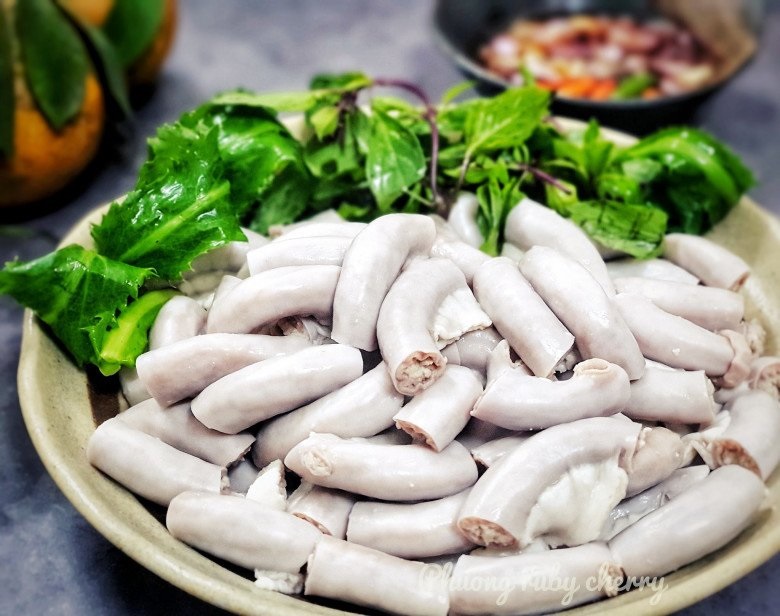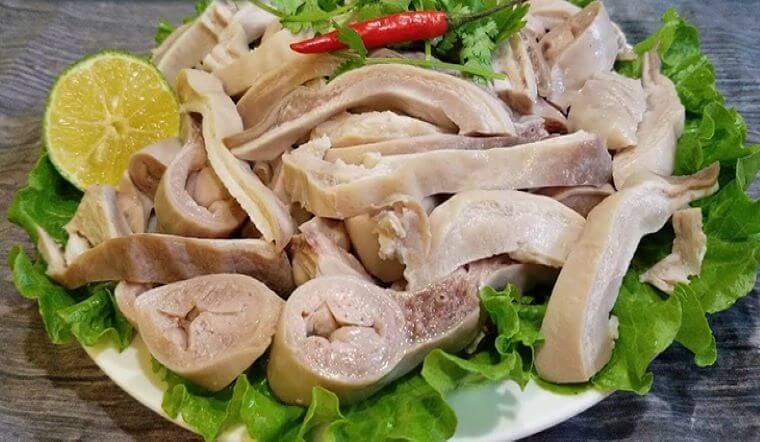Why do pig intestines outside the stomach often appear white, odorless, and crispy? Find useful tips below:
Not everyone can boil a plate of intestines that are both white and crispy, without being tough. Here are the reasons why the dish of boiled pig intestines is not delicious that you should avoid.

Mistakes when boiling pig intestines
- Buying non-standard intestines: You need to avoid intestines that are thin and transparent, with yellowish liquid inside, as they are often tough and bitter. It is best to choose the head part of the intestines because this part is thicker and crispier than the tail part, with the intestines round and the liquid inside white. However, this part is usually sold out quickly and if you can’t buy it.
- Boiling intestines in cold water: The boiled intestines will be tough if you put them in cold water and then gradually heat it up. This is the most serious mistake. The correct way is to boil the water vigorously and then put the intestines in.
- Boiling for too long: The intestines will be tough if boiled for too long. After putting the intestines into the boiling water over high heat, you must quickly remove them when they are just cooked to ensure crispness.
- Letting the intestines cool down after removing them: After removing the intestines, you should immediately put them into a bowl of cold water (adding some ice cubes is even better) with squeezed lemon, the intestines will be crispy and white. If you leave them on the plate to cool down by themselves, the dish will not only be tough but also turn dark, dry, and less attractive.
Secrets to boiling pig intestines white, crispy, and not bitter
When boiling
Avoid boiling intestines and stomachs in cold water. Boil the water first and add spices, then put in the intestines. Boil again for 1-2 minutes, then remove them, don’t boil for too long.
Once removed, put the intestines into a bowl of cold water with vinegar and prepared ice. Cold water causes the intestines to shrink suddenly, making them crispy, and vinegar helps the intestines become white, odorless, and crispier.
Add some ginger for a more aromatic flavor.
Boil the water for 2-3 minutes until the intestines turn pink, then remove them and soak them in a bowl of cold water with a few drops of lemon. By doing this, the intestines will be crispy, have a beautiful white color, and not turn black. Normally, the total time from putting the intestines into the boiling water to removing them is about 7-10 minutes (depending on the amount of ingredients).

For the stomach, you need to boil it longer. You can apply the following method: Put the stomach in boiling water, bring it to a boil again, then remove it and immerse it in a bowl of ice water, then put the stomach back into the boiling water, bring it to a boil again, and then remove it. The stomach takes longer to cook, so you may need to do it about 3 times for the stomach to be cooked.
Note: Using vinegar diluted water is a convenient and inexpensive method that many restaurants apply to make the stomach crispy, white, and eliminate the odor. However, when using this method, you need to heat the vinegar to reduce toxins.

Therefore, besides using vinegar, you can use lemon diluted in cold water. Careful restaurants will use lemon, but using lemon will be more time-consuming and costly.
In conclusion, to boil delicious intestines, you need to pay attention to 3 points: Do not clean the intestines too thoroughly, which makes them thin and tough. Do not boil from cold water, but boil from boiling water. The stomach should be only cooked until it is cooked, overcooking will make it tough. After boiling, immediately put the intestines into cold water with lemon (or vinegar diluted water).


































